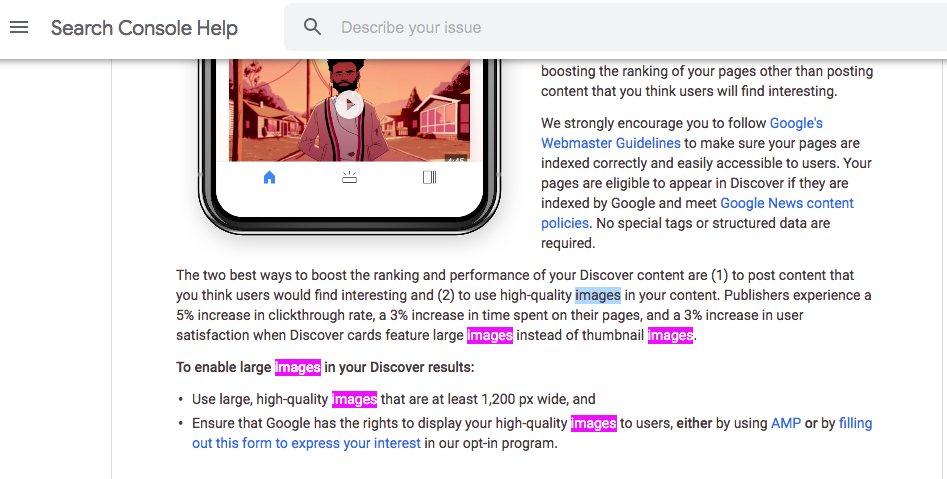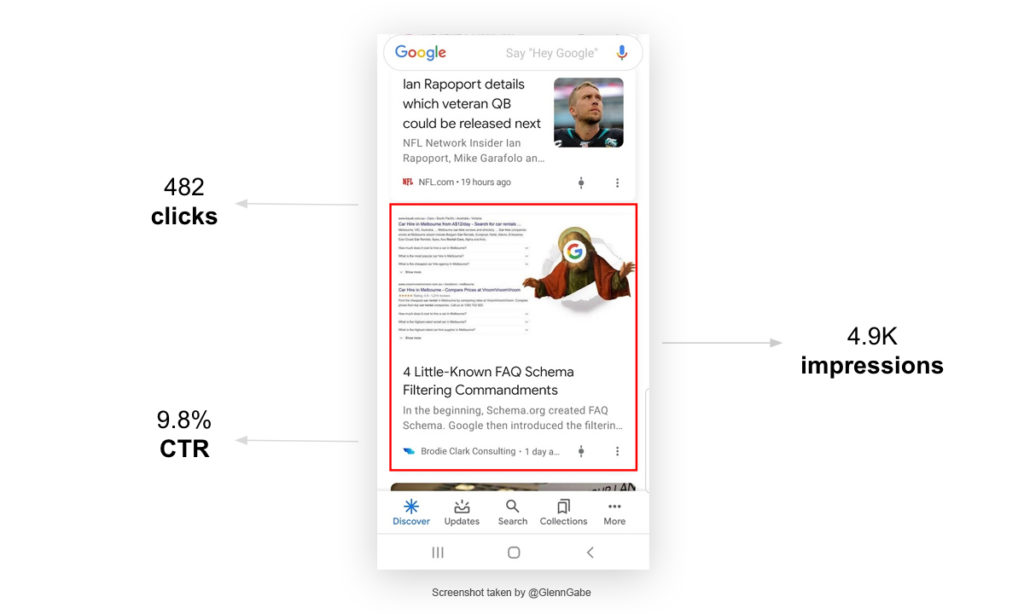Google Discover, when images are more than words
A picture says a thousand words. It may just seem like a cliché, but it’s actually exactly what happens with Google Discover, the news feed selected by Google that appears on users’ smartphones whenever they open the search engine app. A case study, in fact, tells us of the value that high-quality images can have to appear in this stream and win the readers clicks.
An increasingly clicked feed
Google Discover is visible through multiple channels: since September 2018 it is present on the home page of the Chrome mobile app (right below the search bar) and also appears in the Google app, on Android and on the right tab of the home screen of some devices.
About six months after the launch, in Google Search Console also debuted the report on the incoming traffic from Discover, the Report on Discover performance (only visible if the property has reached a minimum threshold of impressions in this feed).
A still young tool to discover
We are therefore faced with a tool that is still rather young but has already shown that it can be imposed as a new and important source of traffic, so much so that the attention of the online marketer community and digital consultants immediately focused on setting strategies to appear on Google Discover.
In many cases, the ratio of traffic volume between Discover and the classic Web Search really is surprising: depending on the industry, the feed can also account for 80 percent of daily visits to a site, while the Web Search brings only the remaining 20 percent of users.
Discover’s benefits
If the increase in organic traffic flow to the site is the first direct benefit of the feed, which generates important (and sometimes unforeseen) peak visits, offering quality content on Discover, too, allows you to get other benefits in terms of engagement and more. We can therefore strengthen brand awareness and brand reputation (more users get to know and appreciate the pages we provide), increase overall visits to the site and the time spent on the pages (people can enjoy more and read other articles), potentially grow shares and incoming links to the pages of the site.
However, also for its relative youth and for the features of the operation system – it is potentially subject to the effects of every Google update intervention on algorithms, the shown contents change constantly and now users have even more possibilities to customize the flow of news, deselecting certain sites that do not want to follow – it is not always possible to rely on Discover as traffic source, and Google itself invites us not to do so to avoid sudden “ugly surprises”.
The case study on Google Discover
The SEO consultant Brodie Clark expressly speaks of a “bizarre world” to refer to this system, and on searchenginejournal tells his experience and his attempts to optimize contents and make SEO for Google Discover.
An example of this bizarre matter is in the analysis of the traffic of the site of one of its customers: an article appeared in Discover and in just 3 days received over 21 thousand clicks and 130 thousand impressions, with an average CTR of 16,7%, but then it dropped sharply to almost zero clicks. More in detail, it is on the first day in the feed that you reach the peak (over half of clicks and impressions) and then the trend drops. According to Clark, it is rare to see an article last more than 3 days in Discover, proving how significant this traffic is, but temporary, rapidly decreasing in the following days.
Looking at the performance of the same article in the traditional Web Search you can find out an equally bizarre situation: in all his life, that page got 353 organic clicks, or 61 times less traffic generated in just three days by Discover.
What kind of control is there on Discover?
Such a situation is understandable, says the author, if we consider the popularity of Google Discover (and the Google app that continually shows news), but it make you ask questions on how to use it best and what control we have on this SEO channel as a source of traffic.
The most obvious answer is: ‘we have very little control at all”, but Clark is not entirely sure of this and he is convinced that there are some optimization strategies that can be put into practice, and with the case study related to his site offers us a demonstration.
The case study: which contents appear on Google’s feed?
“For any site that I’ve worked with that is looking to receive Discover traffic”, says the author, “I find there to always be that breakthrough article that makes them more likely to be considered for future pieces of content”. This situation has also been repeated for the personal blog of Brodie Clark, which then retraces the path that led to this breakthrough moment.
His blog is a simple space on which to publish more in-depth and reasoned content that can represent the consultancy activity; only recently he has begun to publish more regularly, with a frequency of about one article every two weeks, and the last article is valid for the case study because it has obtained the highest number of visits of all the others.
Specifically, the monitoring in Search Console reports about 1500 sessions on the page, focused on the topic Schema markups FAQ; the greatest part comes from social medias (about 40 percent), but the rest came through the “direct” and “referral” channels. More in detail, the article got from Discover 482 clicks and 4.9K impressions in 3 days, same time period previously identified
The importance of images on Discover
The secret to get positive results on Discover seems to be the work of images optimization: it is easy to guess it even by simply reading the Google guide on this specific tool, in which it is specified that it is important to use high quality images in content, with 6 references to “images” in the original text.
Basically, tips are:
- Use high-quality images.
- Be sure the images are big and not just thumbnails.
- Length must be at least 1.200 pixels.
- Make sure that Google have all the rights to display your images, using AMP or filling in a specific form.
Clark says he has published the article by taking care of all the details, inserting some images (even comical ones) and screenshots from Google, but to capture the attention in the end is probably the image of a person who pierce the page with a Google logo instead of the face.
The image itself, then, could be the means to give a boost to the page (also) on Discover: if on average the CTR of this tool is close to 8 percent, for this article it rose to 16.7 percent, thus bringing thousands of extra clicks to the site.
How to get a perfect image for Google Discover
Based on his experience, the author argues that the starting point is to make sure that the images are of the correct size: for the one in evidence and for the Open Graph image to be conveyed on socials we must use resources of at least 1600 x 840 pixels, then using the validation systems of various social networks to check that there are no problems.
Moreover, the multimedia resource must be unique, professionally designed, it must center important elements and with the correct sizing specifications.
The details of the image to take care of
The high quality is also crucial to another factor: whenever Google uses an image as a thumbnail in Search on mobile devices or tablets, it destroys its quality, so it is important to start from a basis of “high definition” so to prevent the quality from falling too low in the process and become really poor.
The thesis is therefore that without a strong image in support of the article, “in many cases you could lose hundreds or thousands of clicks”, but obviously everything else is also important, like the title used, the content of the article, the publication site and other various signals on the Web showing that it is a worthy post.




